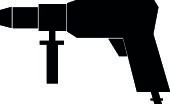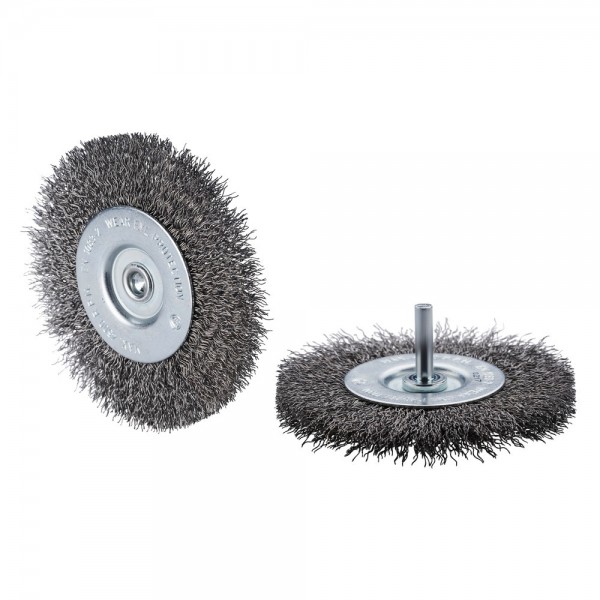ERBWBM
ERBWBM
Content: 10 Unit
Prices incl. VAT plus shipping costs
- Order number: 353269
- Please select your desired product variant here:
Stainless steel wheel brush with crimped stainless steel wire on a 6 mm shank for use with handheld drills.
Machine suitability:
The ERBWBM technical brush is designed for use on a handheld drill with a drill chuck. Please note the information about working and safety speeds. The maximum safety speed is marked on every product. This speed is important to ensure your safety in the workplace and must never be exceeded. Using adjustable-speed machines permits speeds to be adjusted to the maximum safe working speed. In addition, brushes fitted to handheld machines must have a maximum outer diameter of 180 mm.
Material suitability:
This brush has been designed especially for processing stainless steel (SST, Inox), e.g. 1.4031 (X5CrNi18-10 or 304), steel (structural steel – also termed St37, S235JR, 1.0037 and carbon steel) and cast steels, as well as aluminium and other non-ferrous metals such as copper, brass and bronze, etc. The product achieves good to very good results when used on any of the materials listed here.
Structure and production:
The fill material used for the ERBWBM is high-quality crimped stainless steel wire. This is the fill material most commonly used for such tools, and is especially suited to light surface treatment and deburring work. The brush is particularly flexible.
Quality:
The ERBWBM provides users with the best RHODIUS tool in its category. RHODIUS TOPline products represent a maximum level of performance and quality.
Applications:
Wheel brushes are the perfect choice for processing solid or hollow rods, sections, welding seams, cutting edges, toothed wheels and grooves as well as narrow surfaces. These tools are used here in particular for roughing, deburring, edge chamfering, matt finishing, structuring, de-rusting, cleaning and slag removal. This RHODIUS wheel brush for stainless steel is the optimum choice for processing rust- and acid-proofed steels, high-strength and high-alloy steels, structural steels, tool steels, tempered steels and high-strength metal sheets.
Dimensions:
The wire thickness for the ERBWBM is 0.30 mm. This wheel brush is available with a diameter of 100 mm.
Industries:
This makes it the ideal tool for the many applications and challenges faced in car repair and metalwork shops, in plant, container, boiler and tank construction, structural steel engineering, pipeline construction and installation work.
Notice:
The brush diameter, the length of brush filler as well as fill material density are all important factors that go towards producing optimum results for surface treatment. A longer wire length will make the brush softer and more flexible. These kinds of brushes will be an excellent choice for processing structured workpieces and for ensuring non-aggressive surface treatment. As wire length shortens, the brush can be used for more aggressive types of processing. To keep surface treatment work as efficient as possible, the best option here is to select the maximum brush diameter that can be fitted to the drive system on your tool. A high fill material density is not only essential for optimum performance but is also needed to ensure a long brush lifetime. In contrast, lower fill material densities increase the flexibility of the wire and are a better choice for processing profiled surfaces.
• For flexible work
• For gentle cleaning
Machine suitability:
The ERBWBM technical brush is designed for use on a handheld drill with a drill chuck. Please note the information about working and safety speeds. The maximum safety speed is marked on every product. This speed is important to ensure your safety in the workplace and must never be exceeded. Using adjustable-speed machines permits speeds to be adjusted to the maximum safe working speed. In addition, brushes fitted to handheld machines must have a maximum outer diameter of 180 mm.
Material suitability:
This brush has been designed especially for processing stainless steel (SST, Inox), e.g. 1.4031 (X5CrNi18-10 or 304), steel (structural steel – also termed St37, S235JR, 1.0037 and carbon steel) and cast steels, as well as aluminium and other non-ferrous metals such as copper, brass and bronze, etc. The product achieves good to very good results when used on any of the materials listed here.
Structure and production:
The fill material used for the ERBWBM is high-quality crimped stainless steel wire. This is the fill material most commonly used for such tools, and is especially suited to light surface treatment and deburring work. The brush is particularly flexible.
Quality:
The ERBWBM provides users with the best RHODIUS tool in its category. RHODIUS TOPline products represent a maximum level of performance and quality.
Applications:
Wheel brushes are the perfect choice for processing solid or hollow rods, sections, welding seams, cutting edges, toothed wheels and grooves as well as narrow surfaces. These tools are used here in particular for roughing, deburring, edge chamfering, matt finishing, structuring, de-rusting, cleaning and slag removal. This RHODIUS wheel brush for stainless steel is the optimum choice for processing rust- and acid-proofed steels, high-strength and high-alloy steels, structural steels, tool steels, tempered steels and high-strength metal sheets.
Dimensions:
The wire thickness for the ERBWBM is 0.30 mm. This wheel brush is available with a diameter of 100 mm.
Industries:
This makes it the ideal tool for the many applications and challenges faced in car repair and metalwork shops, in plant, container, boiler and tank construction, structural steel engineering, pipeline construction and installation work.
Notice:
The brush diameter, the length of brush filler as well as fill material density are all important factors that go towards producing optimum results for surface treatment. A longer wire length will make the brush softer and more flexible. These kinds of brushes will be an excellent choice for processing structured workpieces and for ensuring non-aggressive surface treatment. As wire length shortens, the brush can be used for more aggressive types of processing. To keep surface treatment work as efficient as possible, the best option here is to select the maximum brush diameter that can be fitted to the drive system on your tool. A high fill material density is not only essential for optimum performance but is also needed to ensure a long brush lifetime. In contrast, lower fill material densities increase the flexibility of the wire and are a better choice for processing profiled surfaces.
Properties:
Quality:

Thickness:
 Wire thickness in mm
Wire thickness in mm Material suitability:
 Stainless steel
Stainless steel  Steel
Steel  Non-ferrous metals
Non-ferrous metals Machine suitability:
 Drill
Drill Product variants:
| Product dimensions | Wire thickness | Maximum revolutions | Content | Article no. | Product category number | GTIN barcode packing unit |
|---|---|---|---|---|---|---|
| 100 x 12 x 22 x 6,0 | 0,30 mm | 4500 U/min | 10 | 353269 | PK08 | 4011890114223 |









![RHODIUS_ref_VLSQUICK_51_MEDIUM_4011890081433_p15.tif[3683] RHODIUS_ref_VLSQUICK_51_MEDIUM_4011890081433_p15.tif[3683]](https://products.rhodius-abrasives.com/media/image/2e/ba/84/rhodius_ref_vlsquick_51_medium_4011890081433_p15-jpg_330x330.jpg)